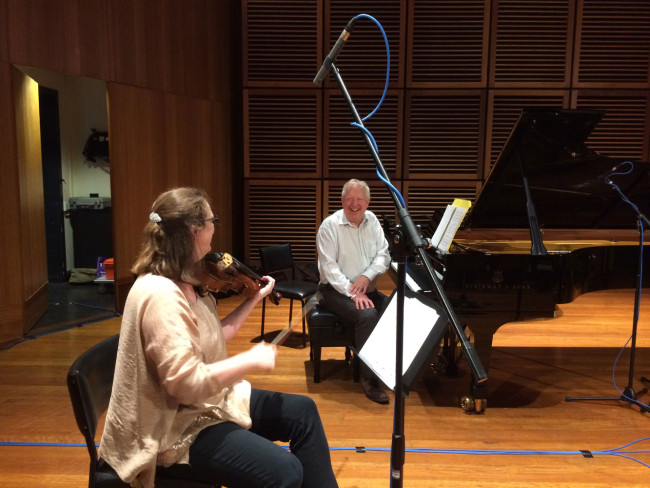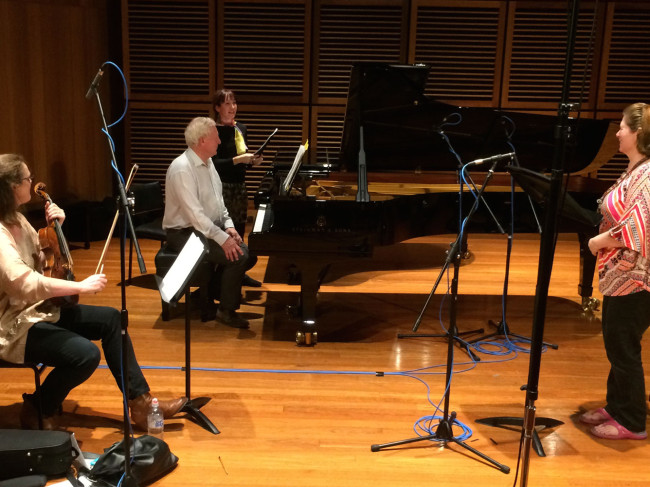
28 – 30 September 2015 – Recording of Afternoon at the Orangerie for soprano, viola, piano (4 movts – 26 min.)
The Grevillea Ensemble: David Miller, Wendy Dixon & guest artist Yvette Goodchild recorded my 26 min. song cycle for radio broadcast.
Recital Hall West, Sydney Conservatorium of Music.
Recording engineers: Ross A’hern & Bob Scott.
Afternoon at the Orangerie for soprano, viola & piano – 4 movts (22 min.)
First premiered in 2013 by the Grevillea ensemble (Wendy Dixon, David Miller) & guest artist Yvette Goodchild, Afternoon at the Orangerie is a Song cycle inspired by Monet’s Water Lily paintings at the Musée de l’Orangerie in Paris.
The piece ends with the players improvising over the four main themes in French:
“la Terre et l’Eau” (Earth and Water), “le Ciel” (the Sky), “le Lever du Soleil” (Sunrise), “le Coucher du Soleil” (Sunset).
Click on photos to enlarge
Program Notes
Afternoon at the Orangerie for soprano, viola and piano, is a song cycle of 4 poems by English romantic poet Percy Bysshe Shelley (1792-1822). Composed for the Grevillea Ensemble and guest artist Yvette Goodchild, this new piece is inspired by Beaugeais’ recent trip to France, where she visited Monet’s Water Lily paintings at the Orangerie Museum in Paris (Musée de l’Orangerie). Monet’s Water Lilies are inspired by his ‘water garden’ in Giverny, France. The eight panels displayed in two large white dome-shaped rooms, evoke the passing of the hours from sunrise in the east to sunset in the west.
In the style of the French composers Ravel, Debussy and Poulenc, Beaugeais’ French background can be heard through the use of lyrical, singing and impressionistic characteristics. Also to emphasize the main themes, selected symbolic words of Shelley’s poems are sung in French. In Afternoon at the Orangerie, Beaugeais gives back the ‘composer/creator’ role to the players, therefore requiring improvisation on certain motifs. Monet’s idea of “capturing the changing qualities of natural light in his garden” is enhanced by this ‘improvisational’ style, producing a fusion of colours, blurred lines and constantly changing textural and timbral effects with the viola’s pizzicato and bird glissando effects.
The first movement presents the listener with the four main themes of Monet’s Waterlilies: water, air, sky, earth, and is therefore the longest movement. It opens with the fast, rippling, ‘water’ motif that forms the basis of the motivic material throughout the piece. The second and third movements portray a calm, tranquil and peaceful atmosphere. The fourth movement is a recapitulation of all the main themes: slow and atmospheric passages, as well as fast, virtuosic, rhythmic melodic sections which showcase the technical ability of the players. In the last section, the improvisational method introduced in the first movement is fully explored. All players improvise over given motifs and the soprano sings specific words in French to highlight the main themes, ending with: “la Terre et l’Eau” (Earth and Water), “le Ciel” (the Sky), “le Lever du Soleil” (Sunrise), “le Coucher du Soleil” (Sunset).









